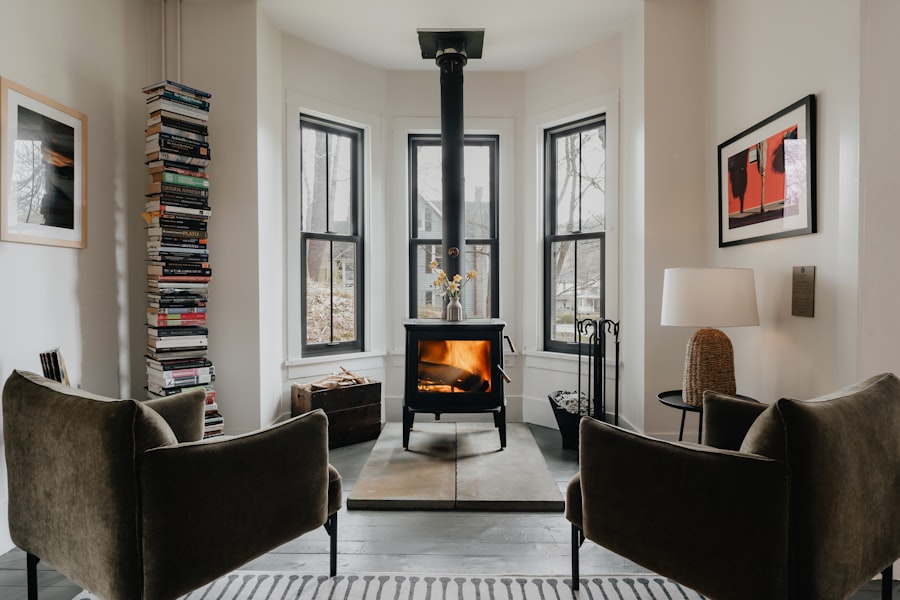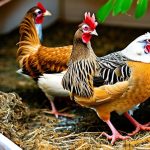Chickens are generally hardy birds with good cold tolerance due to their ability to fluff their feathers, creating an insulating layer of warm air. However, cold tolerance varies among breeds. Cold-hardy breeds like Plymouth Rock, Orpington, and Wyandotte are better suited for colder temperatures compared to Mediterranean breeds such as Leghorns and Minorcas.
Young chickens and older hens may be more vulnerable to cold, as their temperature regulation is less efficient. The health and condition of chickens also affect their cold tolerance, with sick or malnourished birds struggling more in cold weather. Understanding chickens’ cold tolerance is crucial for providing appropriate care and shelter during winter.
Chicken keepers must consider factors such as shelter type, bedding, and supplemental heat to ensure their flock’s well-being. Observing chicken behavior in cold weather is important, as signs of distress may indicate the need for additional protective measures. By comprehending chickens’ cold tolerance, keepers can make informed decisions to support their flock’s health and comfort during winter months.
Table of Contents
- 1 Providing Proper Shelter for Chickens in Winter
- 2 Supplementing Heat for Chickens in Extreme Cold
- 3 Monitoring Chicken Health and Behavior in Winter
- 4 Adjusting Feeding and Watering Practices for Winter
- 5 Implementing Bedding and Insulation for Winter Coops
- 6 Considering the Benefits and Risks of Keeping Chickens Warm in Winter
- 7 FAQs
- 7.1 What are the temperature requirements for chickens in winter?
- 7.2 Do I need to keep my chickens warm in winter?
- 7.3 What are some ways to keep chickens warm in winter?
- 7.4 What are the risks of keeping chickens in cold temperatures?
- 7.5 Are there any specific breeds of chickens that are better suited for cold climates?
Key Takeaways
- Chickens can tolerate cold temperatures better than heat, but extreme cold can still be harmful to them.
- Proper shelter for chickens in winter includes a draft-free coop with good ventilation and protection from wind and moisture.
- Supplementing heat for chickens in extreme cold can be done with heat lamps or heated pads, but caution must be taken to prevent fire hazards and burns.
- Monitoring chicken health and behavior in winter is crucial, as signs of distress or illness may be more subtle in cold weather.
- Adjusting feeding and watering practices for winter includes providing high-energy foods and ensuring access to unfrozen water.
- Implementing bedding and insulation for winter coops helps to keep chickens warm and dry, reducing the risk of frostbite and respiratory issues.
- Considering the benefits and risks of keeping chickens warm in winter involves weighing the potential health benefits against the cost and effort of providing supplemental heat.
Providing Proper Shelter for Chickens in Winter
Providing a Warm and Dry Shelter
During the winter months, it’s crucial to provide chickens with a warm and dry shelter to protect them from the harsh weather conditions. The chicken coop should be well-ventilated to prevent moisture buildup, but it should also be draft-free to keep the chickens from getting chilled. Insulating the coop with materials like straw, hay, or wood shavings can help retain heat and provide a comfortable environment for the chickens.
Maintaining a Consistent Temperature
Additionally, ensuring that the coop is free from drafts and leaks will help maintain a consistent temperature inside the shelter. It’s also important to provide roosting bars for the chickens to perch on, as this will keep them off the cold ground and help prevent frostbite on their feet.
Considering Coop Size and Overcrowding
In addition to providing a warm and dry shelter, it’s important to consider the size of the coop in relation to the number of chickens being housed. Overcrowding can lead to increased moisture and ammonia levels, which can be detrimental to the health of the chickens in winter. Providing proper shelter for chickens in winter involves creating a space that is not only warm and dry but also spacious enough to accommodate the flock comfortably.
Ensuring a Safe and Comfortable Winter
By taking these factors into consideration, chicken keepers can ensure that their birds have a safe and comfortable place to weather the winter months.
Supplementing Heat for Chickens in Extreme Cold

In extreme cold temperatures, it may be necessary to supplement heat in the chicken coop to ensure that the birds stay warm and healthy. This can be achieved through the use of heat lamps, heated pads, or radiant heaters designed specifically for poultry. It’s important to place heat sources in a safe and secure manner to prevent fire hazards and potential injuries to the chickens.
Additionally, it’s crucial to monitor the temperature inside the coop regularly to ensure that it remains within a safe range for the birds. Supplementing heat for chickens in extreme cold can help prevent issues like frostbite and hypothermia, especially for breeds that are less cold-tolerant. While supplemental heat can be beneficial in extreme cold, it’s important to use caution and avoid overheating the coop.
Overheating can lead to excessive moisture buildup, which can create a breeding ground for bacteria and mold. It can also cause the chickens to become dependent on artificial heat, making it more challenging for them to acclimate to natural temperature fluctuations. By carefully monitoring the temperature and providing supplemental heat only when necessary, chicken keepers can help their flock stay comfortable and healthy during periods of extreme cold.
Monitoring Chicken Health and Behavior in Winter
Monitoring chicken health and behavior in winter is essential for identifying any issues or concerns that may arise due to the cold weather. Keepers should pay close attention to signs of distress or discomfort in their flock, such as lethargy, decreased appetite, or unusual behavior. Additionally, regularly checking for signs of frostbite on combs, wattles, and feet can help prevent serious health issues in the chickens.
It’s also important to monitor egg production during the winter months, as cold temperatures can impact laying patterns and overall egg quality. In addition to observing physical health, monitoring chicken behavior in winter can provide valuable insights into their well-being. For example, observing how the chickens huddle together or seek out warmer areas in the coop can indicate whether they are feeling cold or uncomfortable.
By staying vigilant and proactive in monitoring chicken health and behavior in winter, keepers can address any issues promptly and ensure that their flock remains healthy and happy throughout the colder months.
Adjusting Feeding and Watering Practices for Winter
Feeding and watering practices should be adjusted during the winter months to ensure that chickens receive adequate nutrition and hydration. Cold temperatures can increase the energy requirements of chickens as they work harder to maintain their body temperature. Providing a balanced diet that includes high-quality feed and supplemental grains can help meet these increased energy needs.
Additionally, offering warm mash or treats like cracked corn can provide extra calories and help keep the chickens warm from the inside out. In terms of watering practices, it’s important to prevent water from freezing by using heated waterers or manually refreshing water throughout the day. Dehydration can be a serious concern in winter, as chickens may avoid drinking cold water, leading to reduced water intake.
By adjusting feeding and watering practices for winter, chicken keepers can ensure that their flock receives the necessary nutrients and hydration to stay healthy and strong during the colder months.
Implementing Bedding and Insulation for Winter Coops

Bedding for a Warm and Comfortable Environment
Bedding materials like straw, hay, or wood shavings play a crucial role in maintaining a warm and comfortable environment inside the chicken coop during winter. These materials provide insulation against the cold ground and help absorb moisture from droppings. Regularly adding fresh bedding can help maintain a dry and clean environment for the chickens while also providing additional warmth.
Insulation for Retaining Heat
Insulating the walls and ceiling of the coop with materials like foam board or reflective insulation can further help retain heat and create a cozy space for the birds. This additional layer of insulation ensures that the coop remains warm and comfortable for the chickens.
Ventilation: The Key to a Healthy Environment
In addition to bedding and insulation, providing adequate ventilation is essential for preventing moisture buildup inside the coop. Proper ventilation helps remove excess humidity and ammonia from droppings while allowing fresh air to circulate. This balance between insulation and ventilation is key to creating a comfortable and healthy environment for chickens in winter.
By implementing bedding and insulation in winter coops, chicken keepers can help their flock stay warm, dry, and protected from the elements.
Considering the Benefits and Risks of Keeping Chickens Warm in Winter
While keeping chickens warm in winter is important for their well-being, it’s also essential to consider both the benefits and risks associated with providing supplemental heat and insulation. The benefits of keeping chickens warm in winter include reducing the risk of frostbite, maintaining egg production, and promoting overall health and comfort for the birds. However, there are also potential risks to consider, such as fire hazards from heat sources, increased moisture levels from inadequate ventilation, and potential dependency on artificial heat.
It’s important for chicken keepers to weigh these factors carefully and make informed decisions about how best to support their flock during winter. By considering both the benefits and risks of keeping chickens warm in winter, keepers can implement strategies that prioritize safety while also ensuring that their birds have a comfortable and healthy environment throughout the colder months. In conclusion, understanding the cold tolerance of chickens is essential for providing them with proper care during winter.
Providing a warm and dry shelter, supplementing heat when necessary, monitoring health and behavior, adjusting feeding and watering practices, implementing bedding and insulation, and considering both benefits and risks are all important aspects of caring for chickens in winter. By taking these factors into consideration, chicken keepers can ensure that their flock remains healthy, comfortable, and well-equipped to handle the challenges of colder temperatures.
If you’re wondering whether you need to keep chickens warm in winter, you may also be interested in learning how to insulate a chicken coop. This article provides helpful tips and techniques for keeping your chickens cozy during the colder months. Proper insulation can make a big difference in maintaining a comfortable and healthy environment for your feathered friends.
FAQs
What are the temperature requirements for chickens in winter?
Chickens are generally comfortable in temperatures ranging from 45-85°F (7-29°C). However, they can tolerate lower temperatures if they are acclimated to them gradually.
Do I need to keep my chickens warm in winter?
Chickens are equipped to handle cold temperatures, but providing some form of supplemental heat or insulation can help them stay comfortable and healthy during the winter months.
What are some ways to keep chickens warm in winter?
Ways to keep chickens warm in winter include providing a draft-free coop, using insulation, adding extra bedding, and using heat lamps or heated waterers.
What are the risks of keeping chickens in cold temperatures?
Chickens can suffer from frostbite, respiratory issues, and decreased egg production if they are exposed to prolonged cold temperatures without adequate shelter or warmth.
Are there any specific breeds of chickens that are better suited for cold climates?
Some chicken breeds, such as the Rhode Island Red, Plymouth Rock, and Orpington, are known for their cold-hardiness and are better suited for colder climates.
Meet Walter, the feathered-friend fanatic of Florida! Nestled in the sunshine state, Walter struts through life with his feathered companions, clucking his way to happiness. With a coop that’s fancier than a five-star hotel, he’s the Don Juan of the chicken world. When he’s not teaching his hens to do the cha-cha, you’ll find him in a heated debate with his prized rooster, Sir Clucks-a-Lot. Walter’s poultry passion is no yolk; he’s the sunny-side-up guy you never knew you needed in your flock of friends!







